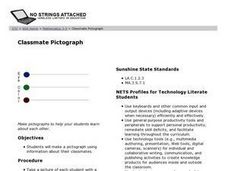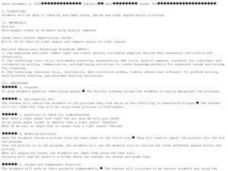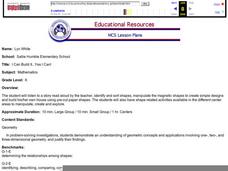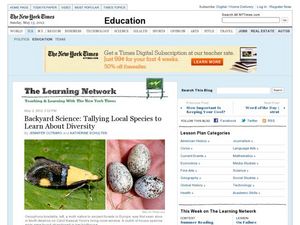Curated OER
Life Through Time: The Heart of the Phanerozoic
Students gain a deeper understanding of geological time and the evolution of life on Earth. They use iMovie to tell a complex story of a discrete time period with narration and images.
Curated OER
Astronomy: Picture Time
Students investigate how to tell time by observing the placement of objects in the sky. Researching on the Internet, they locate the time for sunrise and sunset, the time the full moon rises, and the difference between clock and solar...
Curated OER
Waste Watchers
Students recognize the importance of saving energy to save natural resources. In this saving energy lesson, students complete a worksheet to find types of electricity meters in their homes. Students use meter readings to calculate energy...
Curated OER
Yes We Can! Students with Autism & Down-Syndrome on the Drums!
To learn about various topics and improve their social skills, learners with special needs play along with music on drums and other sound objects. Teachers take digital pictures of the students participation and use them to make bulletin...
Curated OER
What Makes Our Community Special?
Explore websites, complete research, and use technological tools to create a final multimedia presentation on what makes a community special. Learners of all ages work with a partner to research an interesting aspect of their community,...
Curated OER
Poetry Creations
Students produce iMovies to share their thoughts of friendship along with poetry creations in this technology-based lesson for the upper-elementary classroom. The lesson includes a link to a "create a poem" site and requires computers...
Curated OER
Classmate Grid
Students interview classmates and record their findings on a coordinate grid using Inspiration or Kidspiration and digital cameras. This lesson is technology-based and includes resource links.
Curated OER
Cardinal Directions
Students discover cardinal directions through the use of digital cameras, compasses, and file folders in this technology-based lesson for early elementary students. Emphasis is placed on student practice and inquiry.
Curated OER
Classmate Pictograph
Young scholars create pictographs using their classmates in this technology-based lesson. The lesson uses Inspiration, or Kidspiration, digital cameras, and a downloadable pictograph template.
Curated OER
Photo-Documenting Earth Art
Students study Earth Art Sculpture and its historic perspectives. They study important Earth Art sculptors, notably Andy Goldsworthy and view works of important Earth Artists. They explore the basic use of digital cameras and journal...
Curated OER
Human Body Parts
Learners create body cutouts of themselves and label specific internal and external organs/parts that are covered in class in this exciting lesson plan on Human Anatomy. Digital cameras and pictures of various internal organs are required.
Curated OER
Book Making
Students make connections with real life experiences and the two languages, including Spanish and English. They create their own books in this project lesson plan to take home and read with their families. Students also use a digital...
Curated OER
Roger Recycle
Young scholars investigate the uses of aluminum and the importance of recycling. they then write a script and produce an informative and entertaining video about about aluminum recycling.
Curated OER
The Cell Phone Age
What kid isn't interested in Cell phones? They are technical and to operate them you must read an informational text. Older elementary students read an informational text, match vocabulary words with their meanings, and create sentences...
Curated OER
Identify and Label Different Types of Angles
Learners identify and label acute, obtuse, and right angles within a picture. Using Kid Pix software and digital photos, they manipulate, identify, and label the angles and describe the angles to a classmate.
Curated OER
"I Believe..." Podcast Style
Use this communication skills activity to emphasize evaluating a speaker's main point and argument. After reading Martin Luther King's, "I Have a Dream Speech" and John F. Kennedy's speech, "I Believe in an America Where the Separation...
Curated OER
I Can Build It.....Yes I Can!
Kindergartners listen to a story read by their teacher, then use magnetic shape pieces to construct simple designes. They "build" their own house using pre-cut paper shapes. This age-appropriate lesson would be an excellent choice for...
Curated OER
Getting to Know You
After going over the five steps of the writing process, pupils fill out "Getting to Know You" worksheets. They trade papers with each other, and have the task of writing a descriptive paragraph about the person whose worksheet they...
Curated OER
Yummy Math
Young mathematicians use bags of Skittles to help them gain practice in graphing and organizing data. They work in pairs, and after they have counted and organized their Skittles, they access a computer program which allows them to print...
Curated OER
Get in Shape with Geometry
Using geoboards, computer programs, and hands-on manipulative materials, elementary schoolers engage in a study of two and three-dimensional geometric shapes. This lesson is chock full of good teaching ideas on the subject, and the...
Curated OER
Life Snapshots
Students create Inspiration webs using graphics or photographs that depict high and low points in their lives. This technology-based Language Arts lesson for the upper-elementary or middle-level classroom is excellent for improving...
CPALMS
Point of View: A Close Reading of Two Bad Ants
Chris Van Allsburg's Two Bad Ants provides third graders with an opportunity to examine point of view and how the point of view of others may differ from their own.
Curated OER
Tallying Local Species to Learn About Diversity
Using this thoroughly-written plan, you can have your junior ecologists exploring local biodiversity. They take a journal outdoors to tally the species that they see. An article is included along with comprehension questions. The author...
Curated OER
What's Your Angle
Students create an original lesson about geometry and angles. In small groups they take pictures using a digital camera of obtuse, acute, right, and straight angles that they find at school. Students use the photos in a computer...

























